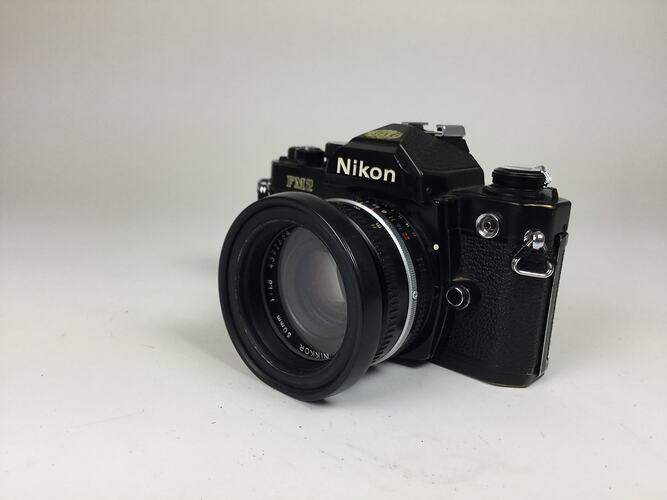Summary
Electronic Nikon FM2 single reflex camera [SLR], manufactured by Nippon Kogaku K. K. (Nikon Corporation) in Japan from 1982 to 2001.
This is part of a Nikon FM2 camera assemblage used by commercial photographer Norman Wodetzki in his photographic business in Melbourne.
Norman Wodetzki used the Nikon FM2 camera assemblage mostly for weddings and events, as well as public relations work at the University of Melbourne, and to record construction sites around Australia.
The Nikon FM2 is an advanced semi-professional camera with interchangeable lens, 35 mm film, single-lens reflex (SLR). It was manufactured by Nippon Kogaku K. K. (today Nikon Corporation) in Japan from 1982 to 2001. The FM2 used an advanced Nikon-design, shutter with a unique speed range of 1 to 1/4000th second plus Bulb, plus a fast flash X-sync of 1/200th second.
The FM2 is a member of the classic Nikon compact F-series SLRs and was built using the same material - copper-aluminium-silicon (copper-silumin) alloy - as the earlier Nikon FM (introduced in 1977) and FE (1978) cameras.
Physical Description
Black metal single lens reflex camera with white brand labelling on front. Nikon Nikkor 50 mm 1:1.18 lens attached but not separately registered. The camera has no strap or lens cap.
Significance
This photographic equipment collection reflects the life of a local working photographer in a small - medium business and the evolution of photographic technology in the second half of the 20th century. Photographer Norman Wodetzki initially used twin reflex Rolleiflex cameras in the 1960s, then bought a 6 x 6 Hasselblad in the 1970s and finally moved on to 35mm electronic Nikons. The museum has very little in the way of cameras manufactured from the 1970s onwards, and few cameras with good provenance. This discreet collection not only fills these gaps but also tells the story of how a professional photographer worked. Norman's working life is being documented by the State Library of Victoria and this record will be available to the museum also, enabling a full picture of his life as a photographer.
Norman Wodetzki is a professional photographer who worked from the mid 20th century through to the early 21st century, when he retired. He began life working as a Victorian Railways clerk and helped a photographer friend from work on weekends with weddings and balls. He then became a working photographer himself. From 1965 he worked for about ten years out of 78 Collins Street Melbourne, above Ogg's Pharmacy, with Lloyd Buchanan. Mr Buchanan used display cases to promote his photography business in the Block Arcade and the Australia Hotel. They often saw competing photographers like Athol Smith at weddings, where there was a distinct division between them. There was a hierarchy amongst Melbourne photographers in terms of who they photographed ie fashion, society, general public etc. Photographers like Athol Smith and Wolfgang Sievers did not consider Norman Wodetzki and Lloyd Buchanan equals with them as Norman and Lloyd catered to the general public as commercial photographers, and were not considered 'artists. Nonetheless, there was enough work for all of them to survive in the local market. [Laurie Richards and Jim Payens whose work is also held by Museum Victoria, were also well known members of the Melbourne photographic community, and further research into the history of Melbourne photographers would be of merit to understand how the Melbourne photographic scene operated].
In 1974 Norman moved to 592 Queensberry Street North Melbourne to work for himself, where he remained until he retired in 2007. He shared the studio space with other photographers to reduce costs. Norman did a lot of work for the University of Melbourne, including Ormond Colleges, PR and various departments, Victorian government departments, CRA [Rio Tinto] and large companies like Multiplex documenting mining projects, construction sites, openings, events and the like. His negatives have been placed in the collections of the University of Melbourne and the State Library of Victoria for archiving, although these were his 'seconds' as most of the high quality negatives were handed over to the commissioning company at the time of photography.
Nikon has made high quality camers in Japan since the 1940s, integrating electronics and optical technology. Nikon camera products are popular amongst professionals.
More Information
-
Collection Names
-
Collecting Areas
-
Acquisition Information
Donation from Mr Norman Wodetzki, Jul 2008
-
Manufacturer
-
User
Mr Norman Wodetzki, 592 Queensberry Street, North Melbourne, Greater Melbourne, Victoria, Australia, 1985-2007
-
Inscriptions
Front: FM2 / Nikon Front, gold sticker, printed in black ink: "PASSED / JCII / C/D JMDC" Back, engraved, white: "N7512817" On base: Made in Japan
-
Brand Names
-
Classification
-
Category
-
Discipline
-
Type of item
-
Overall Dimensions
140 mm (Width), 115 mm (Depth), 100 mm (Height)
-
References
Nikon FM2 in: [Link 1] Sourced 1st November 2017
-
Keywords
